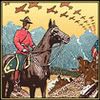
Fifteen or twenty years ago, for reasons I can’t recall, I found myself in Victorville, California, home of the Roy Rogers Museum. I had a couple of hours to kill so I decided to look around.
Roy had been a huge Western star for a couple of decades before I discovered him in my childhood. By then he was well known as “The King of the Cowboys” with a weekly TV show starring himself, his wife, his horse and his dog.
Though not an actual monarch, Rogers was as wealthy as one, listed among Hollywood’s box office leaders from 1943 – 1952.
But Roy’s empire wasn’t restricted to the movies.
Born into poverty in a Cincinnati tenement, he’d had to seek factory work as a child to support his family. He never finished high school, quitting after he was chastised for falling asleep in class – after a night shift making shoes.
His family travelled West during the depression, with Roy learning to play the guitar and sing in the transient and worker camps later made famous in John Steinbeck’s “The Grapes of Wrath”.
He broke into show business in the 1930’s as a country singer, forming a group called “The Sons of the Pioneers” and meeting his wife Dale Evans (later “The Queen of the West”) at an Oklahoma radio station where she gave him with a lemon pie to coerce him into playing a song she’d requested.
The Sons had several hits that eventually landed them spots in a few Westerns, including a Gene Autry movie that the star exited on the first day in a contract dispute. Stuck for a star, the producers noticed the handsome young man with the guitar, handed him a white Stetson and the rest – as they say – is history.
But Rogers not only copied Autry’s singing cowboy character, he improved on it. In a 1940 contract negotiation he gave back some of the money the studio was offering to acquire the rights to his likeness, voice and name.
Within a couple of years, he’d parlayed that into his own production company, radio serials, comic books, adventure novels, public appearances, records, action figures, western clothing and toy six guns of all description.
Only Walt Disney had more merchandise bearing his name.
Already a cottage industry, one that soon expanded to include Dale, trusty mount Trigger and dog bullet, Rogers took over creative control of his films, shooting them in color when everybody else was still making their low budget oaters in B&W.
The West of Roy Rogers films had nothing to do with the Real West and he knew that. But he understood that most people dealt with enough reality in their own lives and wanted something else when they bought a ticket to one of his films.
I thought the museum was kind of tacky. It was weird looking at the taxidermied Trigger, Dale’s horse “Buttermilk” and Bullet posed around the corral set from Roy’s Ranch I’d remembered from childhood.
The racks of rhinestone and silver saddles, handmade Technicolor boots and shirts all seemed phoney and dated.
And after watching film clips of shows I’d loved that now came across as awkwardly concocted and badly produced, I wondered why so many people had bought into the Roy Rogers myth.
I got my answer yesterday as the media marked the 100th anniversary of Roy Rogers’ birth.
In an interview with Rogers’ son, who still makes a good living touring with his own son performing a show featuring the music and stories of his father, there was this insight…
"He came at a time when World War II was coming on pretty heavy and a lot of people, their dad didn't come back or they came from broken homes, so Dad, was a father figure to a lot of kids."
"And so they looked up to him and they knew they could hang their hat on what he would ask them to do. To go to church on Sundays and to keep yourself neat and clean and take care of your animals and obey your mom and dad, and just basic, common sense things."
The museum in Victorville closed a few years ago and its artefacts were sold for millions. Trigger alone went for more than six figures.
Roy Rogers may have been a cowboy caricature and a walking merchandising campaign, but he spent much of the fortune he earned realizing the values he espoused, advocating for adopted children, kids with polio and research into Downs Syndrome.
He also did much for environmental causes, animal rights and ensuring that the history of the west, the “Real” West was preserved.
He closed every episode of his TV series singing one of his biggest hits, “Happy Trails”. You always felt he really meant the sentiment and maybe that’s the part of the man we should most remember.
Enjoy Your Sunday.






No comments:
Post a Comment